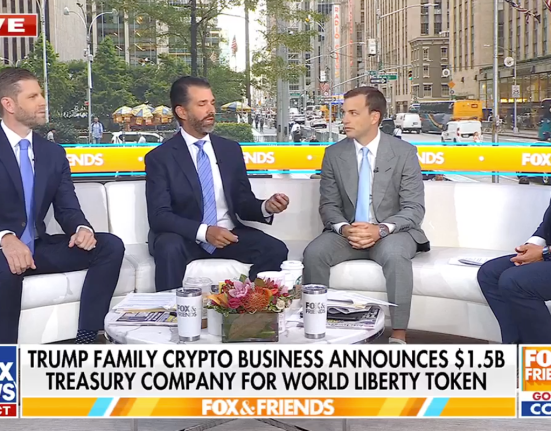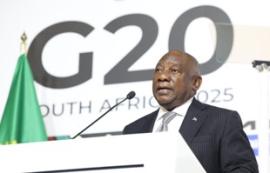This is an audio transcript of the FT News Briefing podcast episode: ‘Trump Administration to roll back banking rules’
Kasia Broussalian
Good morning from the Financial Times. Today is Monday, May 19th, and this is your FT News Briefing. The UK and the European Union are looking to patch things up. And US regulators want to roll back major banking rules. Plus, China is going all-in on electric power. I’m Kasia Broussalian, and here’s the news you need to start your day.
[MUSIC PLAYING]
The UK and the EU are holding their first summit today since Brexit. Senior European officials will meet Prime Minister Keir Starmer in London to sign a defence and security partnership. It’s a significant move for both sides. They’re trying to make up after a messy divorce. But don’t quite call it a reset, at least not yet. One of the big things still on the agenda is long-term access to UK fishing grounds. The EU wants it, but the UK is on the fence. The current agreement is supposed to expire next June.
[MUSIC PLAYING]
The US put in some serious banking regulations after the 2008 global financial crisis. Now there’s a move to claw some of them back. Regulators will soon announce a big cut to capital requirements. It’s all part of the Trump administration’s promise to deliver a new era of deregulation. My colleague Martin Arnold has been covering the changes and he’s here with me now. Hey Martin. (Hello) So these capital requirements just quickly explain to me what they’ve been up until now and their purpose.
Martin Arnold
So the regulation that we’re talking about here and that the US authorities are preparing to reform is called the supplementary leverage ratio, which came in in 2014 as part of a big wave of reforms that were designed to shore up the banking sector after the 2008 financial crisis. And what it does is it just looks at the total amount of exposure, loans and other assets that banks have on their balance sheet and even those that they have off balance sheet, adds them all together and then calculates how much capital they have as a percentage of that and it sets a minimum for the banks and then for the biggest banks it has this supplementary leverage ratio that has an add-on to that. So it takes for the big banks, it means they have to have 5 per cent of all their assets in capital.
Kasia Broussalian
So these regulations have essentially forced banks to set aside like a rainy-day fund that then they could tap into when some parts of the market went south. But what is the Trump administration looking to do now?
Martin Arnold
Yeah. So there are two options that we understand. The first one is to bring the US in line with international norms. The US has had a kind of gold plating where they require their eight biggest banks to hold an extra buffer of capital above the minimum level that all the other banks have to hold. And that buffer is bigger than the equivalent banks in the rest of the world.
The other option that they’re looking at is instead of bringing down the level of capital that is needed against total assets, they’re looking at excluding certain types of assets from the calculation. In particular, what they’re looking at are the least risky assets that could be excluded. So that’s treasuries, it’s deposits with the central bank in particular.
Kasia Broussalian
All right, so they wanna bring regulations in line with international standards and maybe exclude assets like treasuries. What is the Trump administration hoping will happen once these requirements are lifted?
Martin Arnold
So the objective seems to be to give some relief to the banks in order to allow them to trade more and act more as intermediaries in the treasury markets, which was a function that banks used to have until these regulations came in. The argument is that if you allow banks capital relief, they will come back into the treasury market, which is clearly one of the most important markets in the world. And that will provide more stability, more liquidity, will help ease some of the strains that we’ve seen after the Trump administration announced the ‘liberation day’ tariffs and that sent the US Treasury market into a serious sell-off.
Kasia Broussalian
But still, I have to imagine that these requirements were put in place for a good reason. And at least to me, it doesn’t really feel like we’re in a super steady financial space at the moment. So what are the risks that we could be looking at in the future?
Martin Arnold
That’s right. Critics say that this is bad timing. And also, we mustn’t forget that it was only a couple of years ago that we had a number of mid-sized US banks falling over. Silicon Valley Bank and others were collapsing. So the banking system, while it does have a lot more capital than it did in the financial crisis, it’s still vulnerable to risks. So the critics would say If you start to allow banks to reduce their capital buffers that will absorb losses in a crisis, you make the banking system much more risky just at a time when volatility in markets keeps bubbling up. So is this the right thing to do?
Kasia Broussalian
Martin Arnold writes about financial regulation for the FT. Thanks, Martin.
Martin Arnold
Thanks very much.
[MUSIC PLAYING]
Kasia Broussalian
European leaders have reached out to Donald Trump. They’re trying to influence the US president ahead of his calls today with Russian President Vladimir Putin and his Ukrainian counterpart Volodymyr Zelenskyy. It kicks off a pivotal week that’s supposed to get peace talks back on track. Some are worried that he might just cut a deal with the Kremlin and overlook what’s best for Ukraine. Trump has positioned the call with Putin as a critical chance to establish some parameters for a permanent end to the war. He’s expected to speak with Zelenskyy right after.
[MUSIC PLAYING]
China is in the middle of an electric revolution. The country used to be completely reliant on fossil fuels, but now it’s on track for 50 per cent of its energy to come from renewable sources. And this move to clean tech could help protect China in Donald Trump’s trade war. Ed White has been reporting on this and he joins me now from Shanghai. Hey Ed. (Hi.) All right, so what does this electrification look like on the ground? I mean, what’s driving this revolution?
Edward White
So in terms of how this is manifesting, perhaps we can look at a few key areas. One is China’s electric vehicle boom. We have seen in the last four or five years, EV sales in China absolutely explode. This year we’re now expecting more than half of all new car sales in China to be EVs. Another really key pillar of this is the electricity grid itself. So China is rapidly expanding and upgrading not just the hardware, so not just wires that transfer electricity, but also the software and the market system that help move power from one side of the country to the other. We’re also seeing a huge amount of money and effort going into securing the resources, so the lithium, the cobalt, the copper, the things that are going to underpin all of these clean technologies.
Kasia Broussalian
And what’s the goal here? What is China trying to achieve by going all-electric?
Edward White
So I think a key point to realise here is that while China’s electrification will have really important economic and climate change outcomes, the underlying reason is all about national security. Xi Jinping, China’s leader has long realised that energy security is so crucial to the Chinese economy being protected from future geopolitical shocks. China is just more secure than it was when Xi Jinping first came to power because its energy system is increasingly self-reliant and its control over the world’s resources that underpin clean technologies is increasingly secure as well.
Kasia Broussalian
So China has become a global leader in this space, but what does that mean for other countries?
Edward White
This has led in many cases to overcapacity. This is something that is hurting other countries because China is left in a position where it has to export surplus products. And we’re also seeing Chinese companies go out into other countries and manufacture increasingly solar, EVs, batteries as well. But basically the complaint from the west is that China’s industrial policy, that is the state lending to its own companies, have shut out foreign rivals and are now meaning that cheaper or low-cost at least Chinese technology is now flooding global markets. And so that is going to be a key issue. It gives China some leverage over not just the US but other countries because everyone’s reliant on China so there’s a limit to how you can push Beijing.
Kasia Broussalian
All right, so China has not only raced ahead in its effort to build out energy independence, but the rest of the world is now more reliant on it for clean tech. How are those two things playing out in the US-China trade war?
Edward White
We’re now at the stage, I think, that it’s becoming increasingly clear that many countries face an extremely stark choice. If they want to pursue decarbonising their own economies, if they want fight climate change, they have to decide whether they’re going to partner with China and use Chinese technologies, or do they try and go it alone? But just given the scale of China’s clean tech industries, it’s extremely difficult to see how many countries will be able to do this without China. And that really changes the nature of the global trading order in the years to come, because in the past, the energy system globally has been dominated by oil and gas and coal, and now we’re moving into a space where it’s gonna be dominated by renewable energy, electric vehicles, transmission infrastructure, and all of that is controlled by China.
Kasia Broussalian
Ed White is the FT’s China correspondent. Thanks Ed.
Edward White
Thank you.
Kasia Broussalian
You can read more on all of these stories for free when you click the links in our show notes. This has been your daily FT News Briefing. Check back tomorrow for the latest business news.







